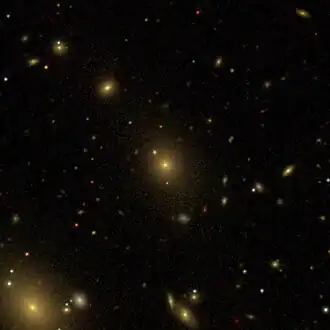NGC 5535
| NGC 5535 | |
|---|---|
 | |
| Observation data (J2000 epoch) | |
| Constellation | Boötes |
| Right ascension | 14h 17m 31.27s |
| Declination | +08d 12m 30.22s |
| Redshift | 0.056804 |
| Heliocentric radial velocity | 17,079 km/s |
| Distance | 831 Mly (254.5 Mpc) |
| Group or cluster | Abell 1890 |
| Apparent magnitude (V) | 15.0 |
| Apparent magnitude (B) | 16.0 |
| Characteristics | |
| Type | E |
| Size | 178,000 ly |
| Apparent size (V) | 0.3' x 0.3' |
| Other designations | |
| PGC 97424, 2MASX J14173129+0812298, MRC 1415+084, [LO95] 1415+084 | |
NGC 5535 is an elliptical galaxy in the Boötes constellation.[1][2] It is located 831 million light-years away and was found by Albert Marth, a German astronomer on May 8th,1864.[3]
NGC 5535 has an active galactic nucleus and considered as a radio galaxy according to SIMBAD,[4] in which expels large amounts of radio waves.[2] It is a member of Abell 1890 galaxy cluster[2] and located to the nearby lenticular galaxy, NGC 5539, which is the brightest galaxy member.
References
- ^ "NGC 5535 - Elliptical Galaxy in Boötes | TheSkyLive.com". theskylive.com. Retrieved 2024-04-17.
- ^ a b c "Your NED Search Results". ned.ipac.caltech.edu. Retrieved 2024-04-17.
- ^ "New General Catalog Objects: NGC 5500 - 5549". cseligman.com. Retrieved 2024-04-17.
- ^ "NGC 5535". simbad.u-strasbg.fr. Retrieved 2024-04-17.